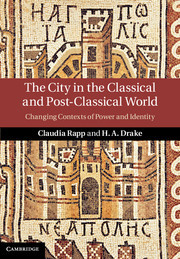The City in the Classical and Post-Classical World Changing Contexts of Power and Identity
Langue : Anglais
Coordonnateurs : Rapp Claudia, Drake H. A.

This volume examines the evolving role of the city and citizenship from classical Athens through fifth-century Rome and medieval Byzantium.
This volume examines the evolving role of the city and citizenship from classical Athens through fifth-century Rome and medieval Byzantium. Beginning in the first century CE, the universal claims of Hellenistic and Roman imperialism began to be challenged by the growing role of Christianity in shaping the primary allegiances and identities of citizens. An international team of scholars considers the extent of urban transformation, and with it, of cultural and civic identity, as practices and institutions associated with the city-state came to be replaced by those of the Christian community. The twelve essays gathered here develop an innovative research agenda by asking new questions: what was the effect on political ideology and civic identity of the transition from the city culture of the ancient world to the ruralized systems of the middle ages? How did perceptions of empire and oikoumene respond to changed political circumstances? How did Christianity redefine the context of citizenship?
Introduction: polis – empire – oikoumene: a world reconfigured Claudia Rapp and H. A. Drake; 1. A covenant between gods and men: hiera kai hosia and the Greek polis Josine Blok; 2. Hellenistic imperialism and the ideal of world unity Rolf Strootman; 3. Lawyers and citizens from republic to empire: Gaius on the Twelve Tables and Antonine Rome Jill Harries; 4. Laws' empire: universalism and legal practice Caroline Humfress; 5. A most unusual empire: Rome in the fourth century Bryan Ward-Perkins; 6. Mobility and identity between the second and the fourth century CE: the 'cosmopolitization' of the Roman Empire Claudia Moatti; 7. City and citizenship as Christian metaphors in the Greek fathers Claudia Rapp; 8. Church-festival-temple: reimagining civic topography in late antiquity Susanna Elm; 9. Leo the Great: responses to crisis and the shaping of a Christian cosmopolis Michele Renee Salzman; 10. The battle of the maps in a Christian empire Emily Albu; 11. Topographies of power in late antiquity and beyond H. A. Drake; Postscript: cities, citizenship, and the work of empire Clifford Ando.
Claudia Rapp is Professor at the Institute for Byzantine and Modern Greek Studies, University of Vienna, and Director of the Division of Byzantine Research, Institute for Medieval Studies, of the Austrian Academy of Sciences. She has published widely on hagiography and the cult of saints, episcopal authority and the city, monasticism, and writing culture in Late Antiquity and Byzantium. She is the author of Holy Bishops in Late Antiquity: The Nature of Christian Leadership in an Age of Transition (2005) and the forthcoming Brother-Making in Late Antiquity and Byzantium: Monks, Laymen and Christian Ritual.
H. A. Drake is Research Professor of History at the University of California, Santa Barbara. He is the author of Constantine and the Bishops (2000). Drake has written extensively on issues related to the transition from a Roman to a Christian empire in Late Antiquity, including political theology and religious violence. He has held fellowships from the National Endowment for the Humanities, the Institute for Advanced Study in Princeton, and the Annenberg Research Institute.
H. A. Drake is Research Professor of History at the University of California, Santa Barbara. He is the author of Constantine and the Bishops (2000). Drake has written extensively on issues related to the transition from a Roman to a Christian empire in Late Antiquity, including political theology and religious violence. He has held fellowships from the National Endowment for the Humanities, the Institute for Advanced Study in Princeton, and the Annenberg Research Institute.
Date de parution : 04-2014
Ouvrage de 243 p.
18.5x26 cm
Thème de The City in the Classical and Post-Classical World :
© 2024 LAVOISIER S.A.S.



